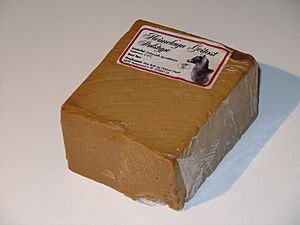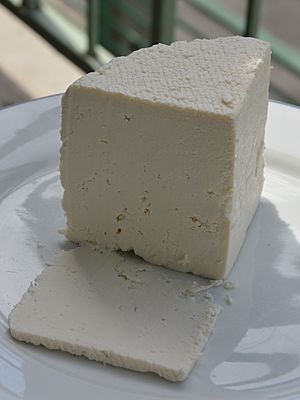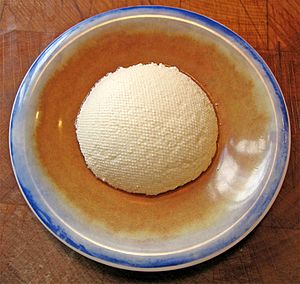Whey cheese facts for kids

Whey cheese is a food made from whey. Whey is the liquid left over after making most other kinds of cheese. When cheese is made, about half of the good stuff from the milk stays in the whey. This includes most of the lactose (milk sugar) and lactalbumin (a type of protein). Making whey cheese helps cheesemakers use this leftover whey instead of throwing it away.
There are two main types of products called whey cheese:
- Albumin cheese: This type is made by heating the whey. Sometimes, acid is added too. This makes the albumin protein in the whey clump together. Examples include ricotta and mizithra.
- Norwegian brown cheeses (Brunost): These are made by boiling the whey for a long time. This makes the sugar in the whey very thick and caramelized. These cheeses, like mysost, are mostly made of this caramelized milk sugar. Because they aren't mainly made from milk proteins that have clumped, they aren't technically "cheese" in the same way as other cheeses.
How Whey Cheese Is Made

Cheesemakers use two different ways to make whey cheese:
- Boiling and Shaping: The whey can be boiled down until it becomes very thick. Then, it's put into molds to give it shape. Cheeses made this way have a lot of milk sugar. They usually look yellowish to brown and taste sweet, cooked, or like caramel.
- Heating and Clumping: Another way is to heat the whey, which makes the proteins clump together. Sometimes, acid is added to help this process. This type of whey cheese has less milk sugar. It is usually white or yellowish. Some cheeses made this way can be aged, meaning they get harder and develop more flavor over time.
For both methods, the whey might be made thicker first before the main cooking or clumping step. Cheesemakers can also add milk, cream, or other milk products. This can happen before or after the whey is made thicker or clumped.
Whey cheeses can be soft or hard, depending on how they are made. Soft, fresh types have a lot of water and go bad quickly. Hard, aged types have much less water. This means they can be stored for a much longer time.
Making whey cheese usually produces less cheese than making regular cheese. This is because whey doesn't have as many nutrients as whole milk. The amount of cheese made depends on what's in the whey. It also depends on if milk or cream is added, how it's made, and how much water is in the final cheese.
Most types of whey cheese have a lot of lactose. This means they are not good for people who are lactose intolerant. However, some, like Brocciu, have less lactose.
Types of Whey Cheese Around the World
Whey cheese is made in many places all over the world. Ricotta is the most famous and popular type. It first came from Italy, but now many people enjoy it everywhere.
Here are some other examples of whey cheeses:
- Anari cheese, from Cyprus
- Anthotyros, from Greece
- Breuil, from the Basque region
- Brocciu, from Corsica
- Brousse (cheese), from Provence, France
- Brunost, from Norway
- Gailtaler Almschotten, from Carinthia, Austria
- Greuilh, from the Nouvelle-Aquitaine region of France
- Lor, from Turkey
- Manouri, from Greece
- Mató, from Spain
- Mizithra, from Greece
- Primost, from Norway
- Recuite, from France
- Requeijão, from Portugal
- Rigouta, from Tunisia
- Schottenziger, from Switzerland
- Sérac, from the French and Valais Alps
- Urdă, from Romania
- Xynomizithra, from Greece
- Xynotyro, from Greece


